Chess — The Essence of Strategy in 64 Squares
If you think about it, there are only 64 squares on the chessboard, half of which are occupied by pieces, yet chess theory is still developing. The unspoken principle of chess is to be the first to capture as much space on the board as possible and impose your game on the opponent because it’s much more difficult to defend than to attack. There is also the option of giving up the center in order to undermine it with the help of pawns and a fianchetto bishop.
The game process is divided into three stages: the opening, the middlegame, and the endgame. The opening ends when all pieces are placed on active squares and both rooks are connected. The middlegame transitions into the endgame when few pieces remain on the board, the king becomes an active piece, and the main priority is advancing pawns to queens.
Pieces
♕ Queen = 9 ♙
♖ Rook = 5 ♙
♗ Bishop = 3 ♙
♘ Knight = 3 ♙
The bishop is strongest in the corner of the board. The knight, on the contrary, should be in the center because that is where it takes control of the most squares. Rooks work best in pairs. If we are talking about the endgame, then the advancement of pawns is most effective when they are supported by rooks behind them, the same principle works against enemy pawns, the rook should stand behind the enemy pawn.
Castling is recorded as two 0-0 or three 000 zeros, short and long respectively. In both cases, the king moves two squares.
Checkmate is impossible:
- With two knights
- With a minor piece, if there are no other pieces left on the board.
In all other cases, checkmate can be done:
- With a queen
- With a rook
- With two bishops
- With a bishop and a knight
The game ends in a draw in case of a threefold repetition or 50 moves without captures.
Terms
Gambit – sacrificing a piece (or quality) for positional advantage.
Fianchetto – placing a bishop in the corner of the board on the central diagonal.
Zeitnot – a situation of time pressure in chess, lack of time in a difficult position.
Zugzwang – a situation where any move worsens the position.
En passant – capturing a pawn en passant when it has moved two squares near an opponent’s pawn.
Promotion – promoting a pawn to any piece.
Time Control
There are four types of time control with and without increment: bullet, blitz, rapid, and classical.
Bullet ~1-2 minutes
Blitz ~3-8 minutes
Rapid ~10-20 minutes
Classical 30 minutes and more
It is important to note that this time is for the individual player’s moves, not for the entire game.
Openings
There are a great many openings and it is impossible to learn them all, but I recommend studying the Queen’s Gambit and the French Defense. These are universal openings and can be played for any setup. They helped me gain a rating from zero to +1500 in just four months. Lately, I have been playing the English Opening for White and the Sicilian Defense, Dragon Variation for Black. These are openings with a fianchettoed bishop.
I strongly advise beginners not to play e4. First of all, it’s a move that Black is most prepared for. Secondly, Black has many response options with endless variations. For the same reasons, I also advise against playing e5 in response to e4.
For what?
Chess is primarily a sport. And so, all the benefits that sport offers are relevant for chess as well. Your success depends on four pillars: strategy, calculation, mnemonics, and psychology. It’s not only about the moves you make, but also how you make them. The speed at which you make them, whether you show your opponent confidence, making them spend more time on calculations, allowing you to think using their time.
If a person doesn’t consider chess a sport, they know nothing about sports. If they don’t consider it a full-fledged sport, they know nothing about chess.
— Mirai Kumiko
But I don’t play for that reason. I simply enjoy them. Unlike other games, whether computer or gambling, 100% of your success depends on you, not on the power of your hardware, your team, or luck. There’s always room to grow. People who started playing them as children play throughout their lives. So, if chess has caught your attention, it’s for the long haul =)
And is it not an art to fit the entire essence of strategy into 64 squares?
